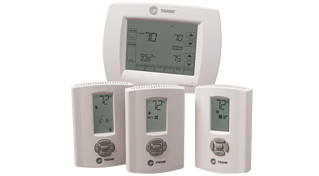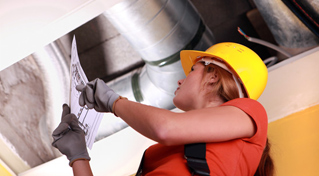How HVAC Control Systems Help
A great way to improve the efficiency of heating and cooling systems is to incorporate control strategies that ensure systems are used only when necessary. Common control strategies include ENERGY STAR qualified programmable thermostats, multiple zones, and CO2 demand sensors. These strategies can be specified on new heating and cooling systems and retrofitted to older systems as well.
- ENERGY STAR Qualified Programmable Thermostats: These simple, easy to install thermostats allow convenient night/weekend setback to save you money. Models range from $50 to $200 depending on the desired features and usually include manual overrides to ensure comfort for late night workers.
- Multiple Zones: By dividing your facility up into multiple heating and cooling zones, your system can deliver more efficient heating and cooling by eliminating inaccuracies from a central sensor point. In addition, building occupants in different areas can adjust the temperature to meet their actual needs. If your facility has many rooms or floors, multiple zones are recommended.
- Demand or CO2 Sensors: Most heating and cooling systems draw in ventilation air by assumed occupancy, however modern technology has side-stepped this by designing systems that actually can regulate the air quality of your facility by measuring the amount of CO2 present. The result is more energy-efficient operation and better air-quality.
What to do to Maintain Your HVAC
Just like your automobile, your facility’s heating and cooling systems need maintenance to operate efficiently. To improve efficiency and help ensure reliability and long life, consider the following tips.
- Engage a qualified HVAC firm in a maintenance contract with seasonal tune-ups. During these tune-ups, a technician should check combustion efficiency, refrigerant charge, and belt tension as applicable. Check NextDoor, the BBB website, Yelp, and other websites to find a good technician.
- Replace air filters regularly. Accumulated dirt and dust make your fans work harder. Clean or replace filters as recommended by your system’s manufacturer.
- Clean the evaporator and condenser coils on your heat pump, air-conditioner, or chiller. Dirty coils inhibit heat transfer; by keeping them clean, you save energy. Instructions for how to clean the coils should be available on the manufacturer’s website.
- Inspect ducts and piping for leakage or damaged insulation. Leaky ductwork is one of the biggest contributors to cooling loss in buildings. Apply duct sealer, tape, and insulation as needed. There are a number of how to videos and articles on how to find those leaks in your AC duct work.
Solar Panels and Backup (Battery) Generation
Did you know that the City of Georgetown Texas has a solar panel and backup generation program? This program is designed for residential and small commercial customers. If you would like to find out more, visit our Distributed Generation here.
TIP – Take It Outside
After washing your clothes, save energy by hanging them outside to dry!
Clothes dryers are among the biggest energy hogs in a typical household.
Air drying your washed clothes, instead of putting them in your loud, energy sucking, house-heating electric dryer is a great way to save energy … and it is making a comeback.
People talk about recovering the lost art of line-drying clothes idea the way our grandparents did it, but the ease and efficiency of modern technology is enticing. It may help to consider the other advantages of line-drying:
- You don’t have to hang around the house to pull out the clothes and fold them before they wrinkle (or set the timer for 4 hours of tumble). After drying, line dried clothes are ready anytime.
- Clothes last longer because they don’t get overheated, which can lead to the shrinking of some things (pants) and the stretching out of others (anything with elastic.)
- Rather than using detergents, whose chemical scents most often fall short of the fresh air they are trying to simulate, with line-dried clothes, you have the real thing!
Air drying your wash uses no electricity, and can be as easy as hanging a cord between two trees or as complicated as installing the big, spinning, pole-mounted one that looks like a huge TV antenna.
Of course, line-drying your clothes may cut down on the electric energy you use, but what about the extra energy needed from you?
The secret is to handle each piece of clothing as little as possible. One way this can be done is by hanging your clothes on plastic hangers, right out of the washer, while they are still wet and hanging the hangers on the clothesline…even those pieces that don’t usually hang on coat hangers, like your leotards and superhero capes. Smaller items, like socks and underwear can be placed on a drying rack. This aids in drying and keeping the wrinkles out, as well as avoiding the little indention’s that the clothes pins can leave in some of the clothes.
Once the clothes are dry, you just grab the hanging clothes and move them to a closet.











